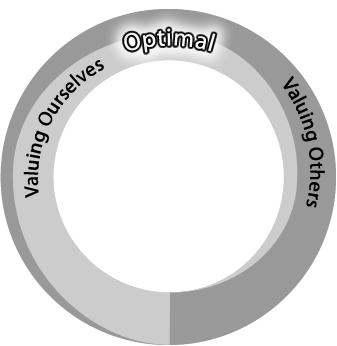Emotion Ring
A tool for Self-reflection and Emotion Coaching
Emotions guide us through life, shaping what we do and underpinning our relationships, thinking and learning. There is no better way to understand ourselves and others than through our emotions. Yet we pay little attention to them in day to day living, perhaps because they are mysterious. However, we are more capable than we think of mastering emotions. We're only born with a basic set of emotions. We learn how to feel a wider range of complex emotions. Emotional well-being is not so much feeling good as being good at feeling. And we can get better at it. Mastery of emotions relies on our capacity to understand their purpose, enabling us to steer our responses.
So what is an emotion? Emotions help us to adapt to our environment. This process begins with making sense of our sensations. Our emotions are our brain’s interpretation of our sensations. Sensations only become meaningful through this process of cognitive framing, where we interpret the cause and purpose of our emotions.
How well we decode our sensations relies on our skills in comparing and sorting emotions. We each have our own way of conceptualising emotions, and it is this hidden web of emotion concepts that frames and colours our experience. The Emotion-Ring provides us with a shared template of concepts to enable reflection and dialogue. This comprehensive set of emotions is organised by purpose which helps us compare them and also see their connectedness.
Two key motivating purposes are Valuing Ourselves and Valuing Others. The model represents these purposes as spirals working in partnership to form the Ring below. Each spiral begins as a point at the bottom of the ring and grows to their maximum at the other end.

Around the ring, as one increases the other decreases. The top half of the ring shows the spirals in workable balance, creating uplifting emotions. Below the half-way mark in both directions, the Ring charts an increasing imbalance between the motives, where we either 'big ourselves up' or 'put ourselves down'. This imbalance causes us to experience challenging emotions.
The ring divides into quadrants, shown below, each one containing emotions with a distinct shared purpose.

On the website individuals can rate their current feelings on the 40 emotions in the chart below by completing the Reflector profile. There is also the Granulator that gives a measure of their current level of emotional understanding of these 40 emotions.

Each quadrant sub-divides into zones that help us to see the connections between similar emotions. See Appendix for zone descriptions.
The uplifting and challenging zones pair up to form eight coloured dimensions. We acquire a special value if we feel the uplifting side in a pair more strongly than the challenging side. These values are the Dimensions of Emotional Wellbeing, as shown in the chart below, the complete Emotion-Ring with 88 emotions.
Below the Emotion-Ring is the Emotional Well-being Reflection Tool, which we can use to plot our current emotional experience on the dimensions.
An accompanying resource, The Compendium of Emotions provides a detailed profile of the 88 emotions along with tailored reflection questions and tips to cultivate and savour uplifting emotions and address challenging emotions.
The Emotion-Ring

Take a highlighter pen and highlight any emotions that have been particularly significant for you lately. When do you feel these emotions?
What are their purposes? What do you do about them?
When we consider an emotion in the context of the ring, we gain greater insight into its purpose. Try this yourself with an emotion that intrigues or confuses you. If the emotion you have selected is not featured on the Ring, it may be a synonym for one of the 88. If not, place your emotion where it fits best around the ring.
Emotional Well-being Reflection Tool

Reflection Exercise
Think of a specific context or relationship you want to think about.
Rate where you are on each scale in the chart above by placing a dot on each line. You may want to give your dot a number from 0 to 100.

Once you’ve done all your ratings, go back and add an arrowhead to each dot to show the direction you're currently moving in.

What's happening to place you where you are?
Place a dot where you would ideally like to be, indicating with a + sign.

What do you need to do to get there?
Are there any specific emotions pulling you down? What's their source?
What emotions are lifting you up? What's their source?
What emotions do you feel most often?
Are any emotions missing from your life?
Write down the most important goals you want to achieve and list alongside them the emotions resulting from achieving these goals. This will show you the emotions you value.
What could you do to achieve them?
Is either of the motivating purposes (valuing self/valuing others) pulling you too far left or right and out of balance in terms of over-valuing yourself or putting yourself down?
To help you explore what's going on with your feelings, you can annotate the chart with details of where and when you feel particular emotions.
For any scales that are important to you, write the names of people you know who would be near the top and the bottom of the scales. What do you have in mind when you think of someone who feels this way? Add these descriptions.
Exploring Emotions within a Relationship
The Emotion-Ring provides a shared frame of reference to explore how we feel within a particular relationship. This can help clarify the dynamics of the relationship that gives rise to certain emotions and enable a constructive exchange of perspectives between partners in the relationship.
Take a highlighter pen and highlight any emotions in the Emotion-Ring that are significant for you within the relationship.
When you feel particular emotions, what is happening between you?
Apppendix Zones & Well-being Dimensions

